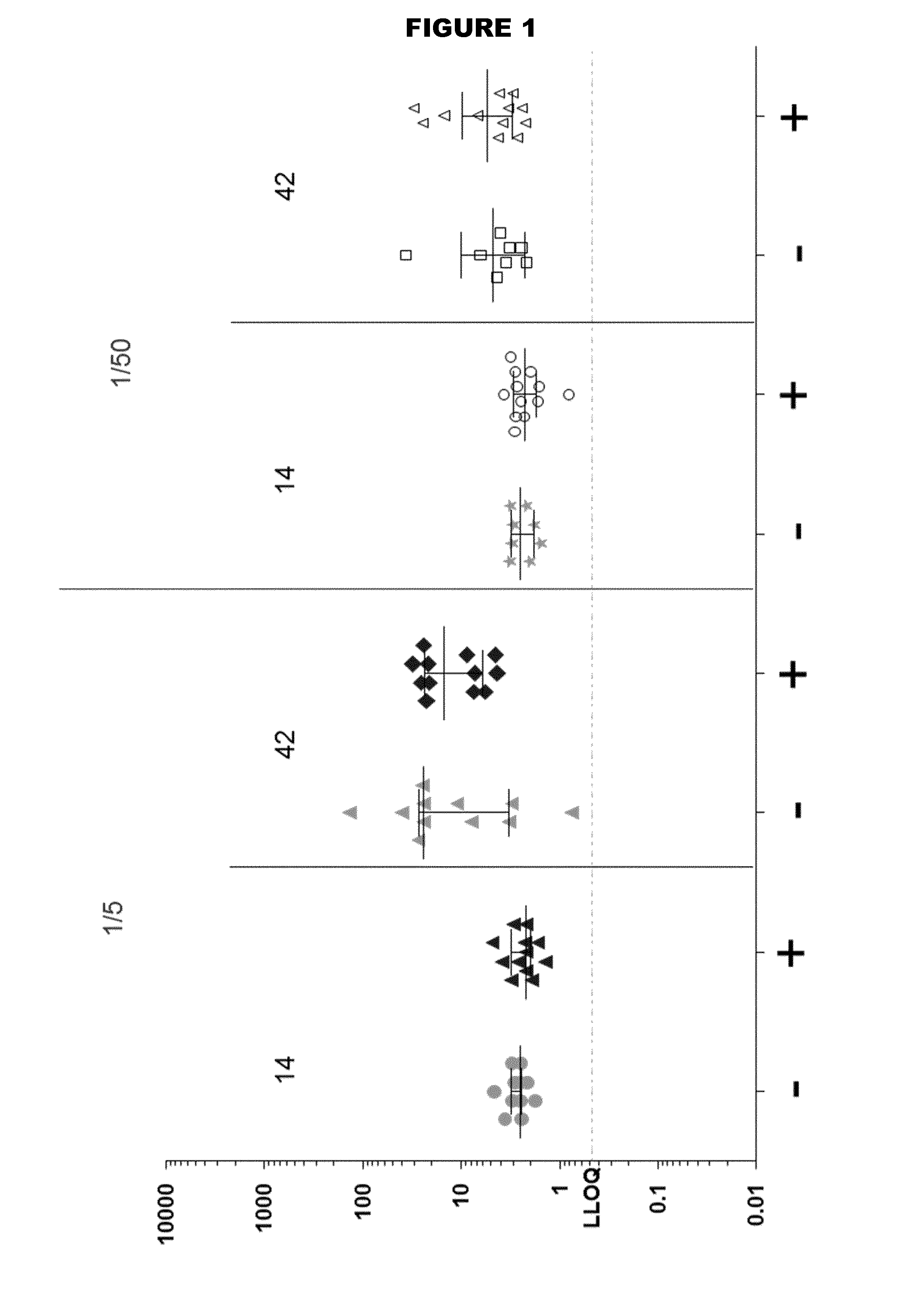Non-cross-linked acellular pertussis antigens for use in combination vaccines
a technology of acellular pertussis and vaccines, which is applied in the direction of viruses/bacteriophages, carrier-bound antigens/hapten ingredients, antibody medical ingredients, etc., can solve the problems of unstable and prone to degradation of pt after genetically detoxification
- Summary
- Abstract
- Description
- Claims
- Application Information
AI Technical Summary
Benefits of technology
Problems solved by technology
Method used
Image
Examples
example 1
Stability of Formylated and Non-Formylated FHA Batches
[0265]Two FHA batches were prepared by purifying FHA from the supernatant of a B. pertussis culture. The supernatant was concentrated and diafiltrated. The filtered concentrate was added onto a hydroxyapatite column. The FHA-containing eluate was further purified by a series of chromatographic steps including a butyl 650M Sepharose column and a Q Sepharose FF column. The resulting purified FHA batches were concentrated and subjected to diafiltration. One FHA batch was additionally incubated in the presence of formaldehyde and lysine, the other batch was left untreated.
[0266]Samples of each batch were incubated at room temperature (RT) for up to one month or at 2-8° C. for up to three months. The initial protein concentration of each sample was determined by measuring the adsorption at 280 nm. The measurements were repeated after incubation for two weeks and one month (samples incubated at RT) or two weeks, one month and three mon...
example 2
Aggregate Formation in Formylated and Non-Formylated FHA Batches
[0268]Formation of FHA aggregates / precipitates during incubation was checked by dynamic light scattering (DLS). Samples were centrifuged before testing. Two peaks were identified: Peak 1 corresponded to the monomeric form and peak 2 corresponded to the aggregate form. A 60° C. angle was used to evaluate aggregate / precipitate formation. DLS analysis revealed that precipitation occurred during storage at 2-8° C. for 3 months whether the FHA was treated with formaldehyde or not. Precipitation could also be reduced by the addition of 0.05% Tween-80 to the formaldehyde-treated sample but not the untreated FHA sample. Aggregation only occurred subsequent to formaldehyde treatment, and further studies showed that aggregation could be reduced by lowering the concentration of formaldehyde used to treat FHA.
example 3
Stability of Vaccine Composition Containing Formylated or Non-Formylated FHA
[0269]Two TdaP vaccine compositions were formulated comprising the following antigens: Tetanus Toxoid (T), Diphtheria toxoid (D), and three purified antigens from acellular Pertussis (aP) (PT, FHA and pertactin). Vaccines were formulated in histidine buffer (100 mM, pH 6.5) supplemented with NaCl (9 mg / ml) and adjuvanted with aluminium hydroxide (2 mg / ml). The FHA in one of the vaccine compositions was derived from a formaldehyde-treated batch, while the FHA in the other vaccine composition was FHA from a batch that had been left untreated.
[0270]Short-term stability studies were performed by incubating samples from each of the two vaccine compositions containing formylated and non-formylated FHA, respectively, for 2 or 4 weeks at 2-8° C., and at 36-38° C.).
[0271]Degree of adsorption of the aP antigens was quantitatively determined using sandwich ELISA. The results are summarised in Tables 1 and 2. No differe...
PUM
| Property | Measurement | Unit |
|---|---|---|
| concentration | aaaaa | aaaaa |
| temperatures | aaaaa | aaaaa |
| volume | aaaaa | aaaaa |
Abstract
Description
Claims
Application Information
 Login to View More
Login to View More - R&D
- Intellectual Property
- Life Sciences
- Materials
- Tech Scout
- Unparalleled Data Quality
- Higher Quality Content
- 60% Fewer Hallucinations
Browse by: Latest US Patents, China's latest patents, Technical Efficacy Thesaurus, Application Domain, Technology Topic, Popular Technical Reports.
© 2025 PatSnap. All rights reserved.Legal|Privacy policy|Modern Slavery Act Transparency Statement|Sitemap|About US| Contact US: help@patsnap.com



